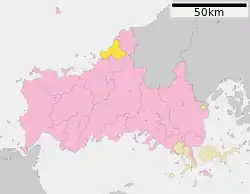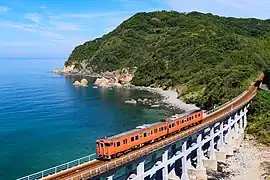Abu, Yamaguchi
Abu (阿武町, Abu-chō) is a town located in Abu District, Yamaguchi Prefecture, Japan. As of 30 June 2023, the town had an estimated population of 3,054 in 1530 households and a population density of 26 persons per km².[1] The total area of the town is 115.95 square kilometres (44.77 sq mi). Noted for its wagyu beef and kiwifruit, the town is a member of the The Most Beautiful Villages in Japan association.
Abu
阿武町 | |
|---|---|
Town | |
 Abu Town Office | |
 Flag  Emblem | |
Location of Abu in Yamaguchi Prefecture | |
 | |
 Abu Location in Japan | |
| Coordinates: 34°30′12″N 131°28′17″E | |
| Country | Japan |
| Region | Chūgoku San'yō |
| Prefecture | Yamaguchi |
| District | Abu |
| Government | |
| • Mayor | Norihiko Hanada (from May 2017) |
| Area | |
| • Total | 115.95 km2 (44.77 sq mi) |
| Population (June 30, 2023) | |
| • Total | 3,054 |
| • Density | 26/km2 (68/sq mi) |
| Time zone | UTC+09:00 (JST) |
| City hall address | 2636, Nako, Abu-cho, Abu-gun, Yamaguchi-ken 759-3622 |
| Website | Official website |
| Symbols | |
| Flower | Rhododendron |
| Tree | Kusunoki |

Geography
Abu is located in northeastern of Yamaguchi prefecture and borders the Sea of Japan on the north. It consists of the Nago area facing the sea, the Udago area, and the Fukuga area in the mountains. Much of the town is within the borders of the Kita-Nagato Kaigan Quasi-National Park
Neighbouring municipalities
Climate
Abu has a humid subtropical climate (Köppen climate classification Cfa) with very warm summers and cool winters. The average annual temperature in Abu is 14.8 °C. The average annual rainfall is 1746 mm with September as the wettest month. The temperatures are highest on average in July, at around 25.9 °C, and lowest in January, at around 4.3 °C.[2]
Demographics
Per Japanese census data, the population of Abu has been declining for the past 50 years.
| Year | Pop. | ±% |
|---|---|---|
| 1940 | 8,580 | — |
| 1950 | 10,837 | +26.3% |
| 1960 | 10,010 | −7.6% |
| 1970 | 7,409 | −26.0% |
| 1980 | 6,272 | −15.3% |
| 1990 | 5,457 | −13.0% |
| 2000 | 4,555 | −16.5% |
| 2010 | 3,734 | −18.0% |
| Waki population statistics[3] | ||
History
The area of bu was part of an ancient Nagato Province. During the Edo Period, the area was part of the holdings of Iwakuni Domain. Following the Meiji restoration, the area was organized into villages of Nago, Fukaga, and Utago within Abu District, Yamaguchi with the creation of the modern municipalities system on April 1, 1889. Nago as elevated to town status on November 3, 1942. On January 1, 1955 Nago merged with Fukaga and Utago to form the town of Abu.
COVID-19 Relief Funds Incident
On April 8, 2022, a municipal official mistakenly transferred Abu's entire COVID-19 relief budget of 46.3 million yen (c. 358,000 USD) to Abu resident Sho Taguchi.[4][5] After promising to return the payment, Taguchi spent the money in online casinos.[4] The incident drew attention from Japan's national news media.[5] On May 18,[6] Taguchi was arrested and indicted for computer fraud for transferring 42.92 million yen of the 46.3 million yen to three online payment agents, knowing that the payment had been made in error.[4] On May 24, the mayor of Abu, Norihiko Hanada, announced that almost 43 million yen of the money had been recovered.[6] On August 1, Taguchi was released on bail after paying 2.5 million yen, and commented that he is going to work and gradually pay the money back.[4]
Government
Abu has a mayor-council form of government with a directly elected mayor and a unicameral town council of eight members. Waki, together with the city of Hagi contributes two members to the Yamaguchi Prefectural Assembly. In terms of national politics, the town is part of the Yamaguchi 3rd district of the lower house of the Diet of Japan.
Economy
The economy of Abu is based on agriculture and commercial fishing, with some forestry in inland mountain areas.
Education
Abu has two public elementary schools and two public junior high schools operated by the town government, and one public high school operated by the Yamaguchi Prefectural Board of Education..
Transportation
Highways
References
- "Abu town official statistics" (in Japanese). Japan.
- Abu climate data
- Abu population statistics
- 日本放送協会. "阿武町誤振込事件 田口被告を保釈|NHK 山口県のニュース". NHK. Retrieved 2022-08-01.
- Ueno, Hisako; Ives, Mike (2022-05-19). "A Town's Covid Money Was Sent to One Man in Error. He Gambled It All Away". The New York Times. ISSN 0362-4331. Retrieved 2022-08-01.
- "Mayor: Town regained nearly all funds it sent man by mistake | The Asahi Shimbun: Breaking News, Japan News and Analysis". The Asahi Shimbun. Retrieved 2022-08-01.
External links
- Abu official website (in Japanese)